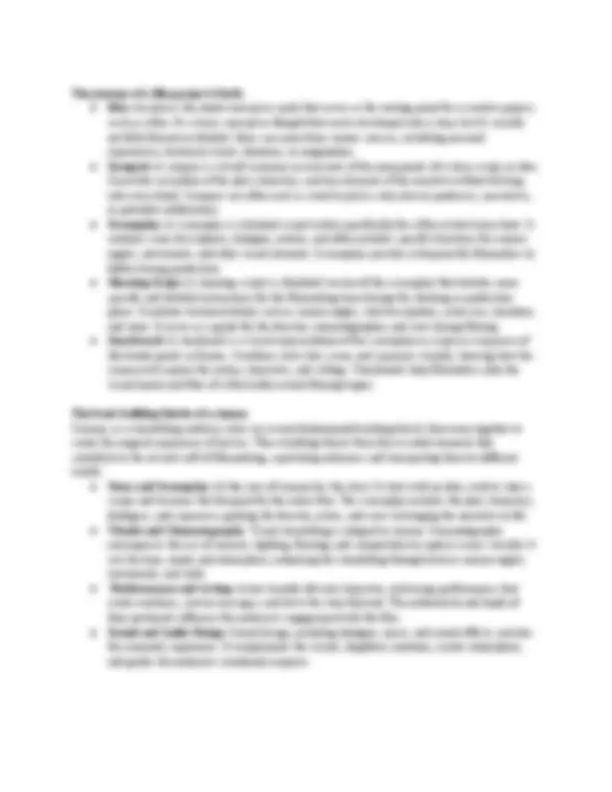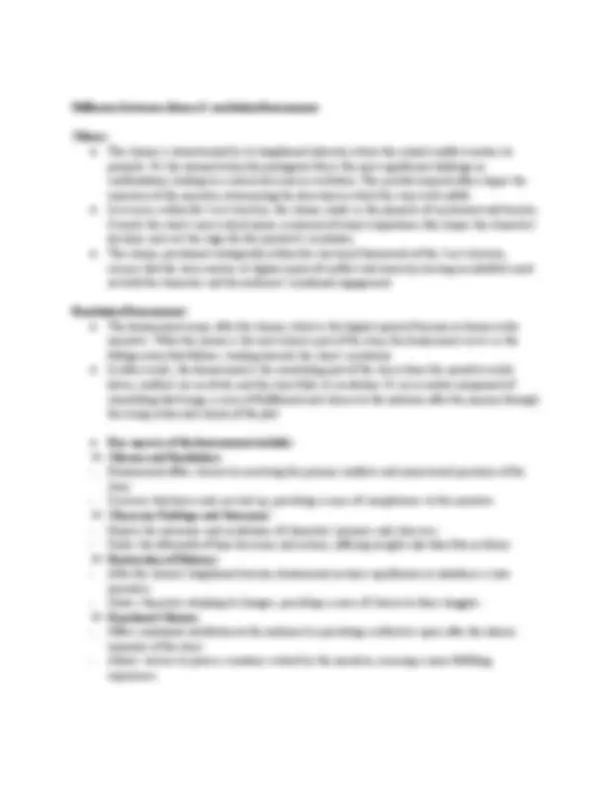







Study with the several resources on Docsity

Earn points by helping other students or get them with a premium plan


Prepare for your exams
Study with the several resources on Docsity

Earn points to download
Earn points by helping other students or get them with a premium plan
Community
Ask the community for help and clear up your study doubts
Discover the best universities in your country according to Docsity users
Free resources
Download our free guides on studying techniques, anxiety management strategies, and thesis advice from Docsity tutors
BASIC NOTES ON FILM THEORY FOR FILMMAKERS AND STUDENTS TO ENHANCE THEIR STUDIES
Typology: Study notes
1 / 9

This page cannot be seen from the preview
Don't miss anything!






What is film making? ● Cinema is a collaborative art form that combines storytelling, visual elements, sound, and technical expertise to bring stories to life in a visual medium. ● Filmmaking is the process of creating movies or films. It involves various stages, including conceptualizing ideas, writing scripts, planning, shooting scenes, editing footage, adding sound and visual effects, etc in order to create a piece of art work for audiences to experience and enjoy on screens. The 3 stages of film production Film production involves three main stages: pre-production, production, and post-production. Each stage is vital in creating a movie, encompassing various tasks and processes that contribute to the final cinematic product.
1. Pre-Production : Pre-production is the initial phase of filmmaking. It involves planning and preparation before the actual filming begins. This stage sets the foundation for the entire project. Tasks in Pre-Production: ● Scriptwriting and Development: It all starts with an idea that evolves into a script. Writers and directors collaborate to craft the story, characters, dialogues, and scenes. ● Storyboarding: Visualizing the script through illustrated panels helps in planning the shots and sequences. Storyboards guide the director and the crew during filming. ● Casting: Selecting the right actors to portray the characters in the film is crucial. Auditions are held, and casting directors work with the filmmakers to choose the best fit for each role. ● Location Scouting and Set Design: Finding suitable locations for shooting and designing sets that match the vision of the film. This includes determining practical considerations like permits, logistics, and set construction. ● Budgeting and Scheduling: Planning the budget for the entire production and creating a shooting schedule. This involves allocating resources, hiring crew members, and organizing logistics. 2. Production: The production stage is where the actual filming takes place. It involves capturing the scenes, performances, and visuals according to the plan laid out during pre-production. Tasks in Production: ● Principal Photography: This is the core filming stage where the director, actors, and crew come together to shoot the scenes. Cinematographers capture the visuals, and the director guides the performances. ● Directing and Managing Crew: The director oversees the filming process, ensuring that the vision of the film is translated into the shots. Assistant directors, camera operators, sound technicians, and other crew members work collaboratively. ● Continuity and Logistics: Ensuring consistency in performances, props, costumes, and settings across different shots or scenes. Managing the day-to-day operations of the production, including handling unexpected challenges
● Capturing Audio and Visuals: Recording high-quality sound and visuals, including dialogue, ambient noise, music, and various shots using cameras, microphones, and other recording equipment. The role of Principal Photography Principal photography is a crucial phase in the filmmaking process where the bulk of the footage that comprises the final film is captured. It's the stage when actors perform scenes as scripted, and the director, cinematographer, and other crew members work together to bring the story to life visually. ● Execution of the Script: Principal photography marks the stage where the screenplay transforms into visual content. The scenes and sequences written in the script are realized through the collaborative efforts of the director, actors, and crew during filming. ● Capturing Performances: This phase allows actors to embody their characters, delivering dialogues, expressing emotions, and performing actions according to the script's requirements. The director guides their performances to ensure they align with the vision of the film. ● Collaboration of Crew and Departments: Principal photography involves coordination among various departments such as cinematography, art direction, costume design, makeup, and more. Each department works together to create the visual and aesthetic elements required for each scene. ● Technical and Artistic Decisions: The cinematographer, in collaboration with the director, makes crucial decisions regarding camera angles, lighting, framing, and visual style during principal photography. These decisions significantly impact the look and feel of the final film. ● Logistical Challenges : Principal photography involves managing logistical challenges such as scheduling actors, securing shooting locations, coordinating equipment, and adhering to budget constraints. Managing these elements efficiently is crucial for a smooth production process.
3. Post-Production: Post-production begins once the filming is complete. It involves editing, adding visual effects, refining the audio, and preparing the final cut of the film for distribution. Tasks in Post-Production: ● Editing: Assembling the filmed footage into a cohesive narrative. Editors work on refining the story, pacing, and visual flow of the film. ● Visual Effects (VFX) and Sound Design: Adding visual effects, graphics, and enhancing scenes digitally. Sound designers and editors work on creating and enhancing audio elements like dialogue, music, and sound effects. ● Color Grading and Finishing: Adjusting the colors and tones of the footage to achieve the desired visual aesthetic. This stage fine-tunes the overall look of the film. ● Marketing and Distribution Planning: Creating promotional materials and planning the release and distribution strategy for the film. In conclusion, film production involves a meticulous process starting from planning and preparation, moving to the actual filming, and concluding with post-production work to create a compelling and cohesive movie that engages and entertains audiences. Each stage requires teamwork, creativity, and technical expertise to bring the filmmaker's vision to life on screen.
● Editing and Post-Production: Editing involves assembling the filmed footage, refining sequences, pacing, and transitions. Post-production processes such as visual effects (VFX), color grading, and sound mixing further enhance the film's quality and coherence. ● Direction and Vision: The director serves as the captain of the ship, shaping the artistic vision and guiding the collaborative efforts of the entire filmmaking team. They make creative decisions, ensuring that the story is translated effectively to the screen. ● Production Design and Sets : Production designers and set decorators create the physical world in which the story unfolds. They design sets, choose locations, and create environments that support the narrative and characters. ● Costumes and Makeup: Costume designers and makeup artists play a crucial role in character development by crafting costumes and makeup that reflect the time period, culture, and personality of characters. These building blocks, when meticulously crafted and combined, result in the immersive and captivating experience that defines cinema. From the initial idea to the final presentation on the big screen, each element contributes to the magic of storytelling, allowing audiences to escape reality and immerse themselves in the world of cinema. Difference between Screenplay/Script & Storyboard Screenplay/Script - Scripts serve as the foundation upon which a film is built. They are written documents that outline the story, characters, dialogue, and actions of a film. Scripts serve multiple purposes in the filmmaking process. They act as a blueprint that guides the director, actors, and crew during filming. Moreover, they provide a clear roadmap for the story's progression, character development, and overall vision of the film. ➔ Elements of a Script: ● Scene Descriptions: Brief descriptions of locations, settings, and actions within each scene. ● Dialogue: Characters' spoken words, conversations, and interactions. ● Action Directions: Instructions for movements, gestures, expressions, and specific actions of characters. ● Character Names : Identification of characters involved in each scene. ● Transition Cues: Indications of transitions between scenes (e.g., cut to, fade in/out) ➔ Purpose of a Script: ● Acts as a blueprint for the entire production process, guiding the director, actors, and crew. ● Provides a clear and structured outline of the story's progression and character development. ● Serves as a communication tool among the production team, ensuring everyone is aligned with the vision.
Things to consider while writing a good screenplay ● Concept and Idea: Begin with a strong and original idea that forms the foundation of your screenplay. Ensure that the concept is intriguing, unique, and has the potential to captivate the audience. ● Structured Storyline: Develop a well-structured storyline with a clear beginning, middle, and end. Create a compelling narrative arc that engages the audience and maintains their interest throughout the script. ● Well-Defined Characters: Create multi-dimensional and relatable characters. Give them depth, flaws, motivations, and unique personalities to make them believable and engaging for the audience. ● Conflict and Stakes: Introduce conflict and tension within the story to drive the plot forward. Establish high stakes and challenges that the characters must overcome to create suspense and keep the audience invested. ● Dialogue and Subtext: Write authentic and meaningful dialogue that reflects each character's voice and advances the story. Incorporate subtext and nuances in conversations to add depth to the characters and their relationships. ● Visual Storytelling: Utilize visual storytelling techniques to convey emotions, themes, and information. Show, rather than tell, whenever possible, using actions, settings, and imagery to enhance the story. ● Pacing and Structure: Maintain a proper pace throughout the screenplay. Balance action, dialogue, and character development to keep the story flowing smoothly. ● Theme and Message: Have a clear theme or message that resonates throughout the screenplay. Ensure that the story explores deeper themes or issues that can evoke emotions and provoke thoughts in the audience. ● Avoiding Clichés and Predictability: Strive to create original and unexpected plot developments. Avoid clichés and predictable storylines that may bore or disengage the audience Storyboard - Storyboards are visual representations of the planned shots and scenes in a film. They consist of a sequence of illustrated panels or frames, with each panel representing a specific shot or scene.The purpose of a storyboard is to provide a visual blueprint for the film's visual elements, enabling directors, cinematographers and editors in their work ➔ Details included in a storyboard ● Visual Frames or Panels: Each frame represents a specific shot or scene. It consists of drawings, illustrations, or images that depict the composition, framing, and key visual elements of the shot. These visual representations give an idea of what the camera will capture. ● Shot Description: Alongside each panel, there's often a description of the shot. This description may include details such as the type of shot (e.g., wide shot, close-up), camera angles, camera movement (if any), and essential actions or elements within the shot.
● Act 2: Complication:
Difference between climax & resolution/denouement Climax ● The climax is characterized by its heightened intensity, where the central conflict reaches its pinnacle. It's the moment when the protagonist faces the most significant challenge or confrontation, leading to a critical decision or revelation. This pivotal moment often shapes the trajectory of the narrative, determining the direction in which the story will unfold. ● In essence, within the 5-act structure, the climax stands as the pinnacle of excitement and tension. It marks the story's most critical point, a moment of utmost importance that shapes the characters' destinies and sets the stage for the narrative's resolution. ● The climax, positioned strategically within the structured framework of the 5-act structure, ensures that the story reaches its highest point of conflict and intensity, leaving an indelible mark on both the characters and the audience's emotional engagement. Resolution/Denouement ● The denouement comes after the climax, which is the highest point of tension or drama in the narrative. While the climax is the most intense part of the story, the denouement serves as the falling action that follows, leading towards the story's resolution. ● In other words, the denouement is the concluding part of the story where the narrative winds down, conflicts are resolved, and the story finds its resolution. It's an essential component of storytelling that brings a sense of fulfillment and closure to the audience after the journey through the rising action and climax of the plot. ● Key aspects of the denouement include: ➔ Closure and Resolution: